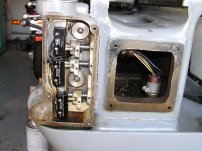Andy FitzGibbon
Diamond
- Joined
- Sep 5, 2005
- Location
- Elkins WV
In my project to familiarize myself with the 10EE, I've looked at a lot of internet photos of them. This one (which HGR sold a while ago) has a small casting on the tailstock end of the bed I havent seen before, which looks like it might be some sort of auxiliary feed rod drive. Anyone know what it is, or if it's factory? Just curious.
Thanks,
Andy




Thanks,
Andy











